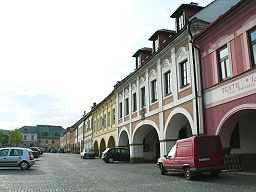Letohrad
| Letohrad | |||
| Town | |||
 | |||
|
|||
| Country | Czech Republic | ||
|---|---|---|---|
| Region | Pardubice | ||
| District | Ústí nad Orlicí | ||
| Commune | Žamberk | ||
| Municipality | Letohrad | ||
| Elevation | 372 m (1,220 ft) | ||
| Coordinates | 50°2′N 16°30′E / 50.033°N 16.500°E | ||
| Area | 23.55 km2 (9.09 sq mi) | ||
| Population | 6,283 (2001) | ||
| Density | 267 / km2 (692 / sq mi) | ||
| First mentioned | 1308 | ||
| Mayor | Petr Fiala | ||
| Timezone | CET (UTC+1) | ||
| - summer (DST) | CEST (UTC+2) | ||
| Postal code | 561 51 | ||
  Location in the Czech Republic
| |||
| Wikimedia Commons: Letohrad | |||
| Website: | |||
Letohrad (Czech pronunciation: [ˈlɛtoɦrat]; until 1950 called Kyšperk; German: Geiersberg) is a town in the Ústí nad Orlicí District, Pardubice Region of the Czech Republic. It has around 6,200 inhabitants. The town lies beneath Orlice Mountains, on the river Tichá Orlice.
Villages Červená, Kunčice and Orlice are administrative parts of Letohrad.
History
Kyšperk
The first mention in a written document comes from 1308 - during the reign of a weak king the castle Geiersberg harbored villain noblemen harassing their neighbourhood. In 1513 Kyšperk was first mentioned as a town. During the last quarter of 17th century the owner of the town Hynek Jetřich Vitanovský from Vlčkovice greatly improved its state: he ordered to rebuild the fortress into a baroque palace, founded a baroque church of St. Wenceslas (this church is beautifully decorated with fabulous plasters (stucco) by the Italian master Giovanni Maderna), handcraftsmen were allowed to establish guilds, and a hospital for poor and old people was founded. The large fire from 1824 burned down 76 houses. In 1874 a railway crossed Kyšperk, starting the growth of industry in the town.
Červená village
The village was called Rotnek until 1950. It is separated from the rest of the town by a cliff called Hrubý kámen with a cross on its top.
Kunčice village
The village was first mentioned in a written document from 1292. In 1685 a brick church building was founded. It was rebuilt in 1761. Castelet Ovčín was built in 1686. From the second half of 19th century until 1922 a phosphorus matches manufacture existed here. The village became a part of Letohrad in 1950.
Orlice village
The place was first mentioned in a written document from 1361 (a small fortress existed here) under its original name Pratum (in Latin). Since 1406 it has been called Orlice. The village has an old church building which was burned down during the Hussite Wars and for the last time was rebuilt in 1711. Since the end of 19th century several textile factories have been built here.
Letohrad today
The main source of employment after World War II have been electrotechnical industry and production of construction materials, as well as agriculture. Paneláks were built to provide housing. After the Velvet Revolution in 1989 the historical centre of the town was renovated.
The town tries to attract tourists with cultural festivals, sport events and rich collection of historical sights.
Letohrad has a partner town Hausen am Albis in Switzerland.
Main attractions of the town
- Letohrad Castle
- Wenceslas's Square with dominating baroque Marian Plaque Column
- Chapel of St. Jan Nepomuk
- Municipal Museum and Museum of Handcrafts
- Park
Notable people
- Painter Alfons Mucha (1860-1939), lived and worked in this town in 1934-35
- František Vladislav Hek (1769-1847), early activist of Czech National Revival, died here
- Diplomat Josef Korbel (1909-1977), father of US politician Madeleine Albright, was born here
External links
- Municipal website (cz)
- Town museum, town history details (cz, en, de, pl)
| Wikimedia Commons has media related to Letohrad. |

